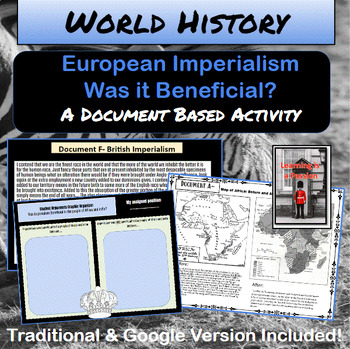European Imperialism | Philosophical Chairs & Document Based Activity
- Zip
- Google Apps™

Description
This 10 page activity packet contains everything your students need to complete a Philosophical Chairs Document Based Activity on the Effects of European Imperialism on Africa & India (using primary sources/secondary sources).
*OPTIONALLY you can use this activity as a simple document based questioning activity instead....
This lesson focuses on how European Imperialism affected Africa and India. Students will read primary/secondary documents that will build upon what they have learned in class about European Imperialism. Students will:
1) Read each primary/secondary source document (excerpt) to understand how the people of Africa/ India were affected by colonization.
2) While examining the documents, students can orally discuss the meaning of the documents with a partner.
3) Students will then complete their graphic organizers to record information that will answer the overall question and support their position: Was Imperialism Beneficial to the people of Africa and India?
4) Once students have added evidence to their graphic organizer from the documents to support their position/argument, the teacher can then direct students to take a position and stand on the correct side of the room (Philosophical Chairs Strategy)
5) Teacher will then call on students on both sides of the question to explain their position using the evidence they wrote down. Students are free at any time to switch sides if they are persuaded by another students arguments. (Teacher will take note and ask student to explain why they were convinced to switch). Students add notes to their graphic organizer during this activity.
6) Students can then use their graphic organizers to complete a creative EXIT CARD activity.
***Includes a GOOGLE and Traditional version for your use!
Follow My Store!
Follow my store... simply click on “follow me” under Learning is a Passion on the top of my store page. You will be the first to receive notifications when I post awesome new products and have sales.
Leave Feedback and Earn Credits
Don’t forget to leave positive feedback after you purchase a product! Leaving feedback will earn you "credits" which can be used for discounts on future purchases. I would very much appreciate your positive comments!
Want more World History products?
The Beginnings of the Industrial Revolution in England: ~A Student Activity~
The Origin of Democracy in Greece and Rome DBQ Activity
Middle Ages: What was life like in a monastery? Document Based Activity
Protestant Reformation: How did the Catholic Church fight back? Activity
Reformation: What were Luther’s arguments in his own words? Document Based Activity
Roman Empire: What were the contributions of the Romans? Student Activity
World History: Art Movements (1700-1890) Power-point & Student Activities
WWII Atrocities: Holocaust and Rape of Nanking Document-Based Activity



